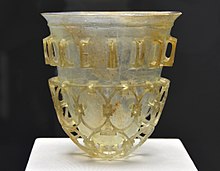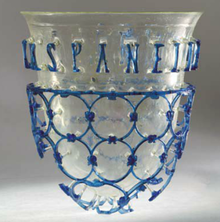Slide glass


A diatret glass ( ancient Greek διάτρητος diatretos "pierced, pierced") is a usually bell-shaped, magnificent double-walled vessel with pierced glass . What is meant by this is that the body of the vessel is surrounded by a perforated glass net. The vessels are therefore also called web mug and English as a cage cups called (cage glasses).
Manufacturing technology
In the post-Roman period, the first such glass was rediscovered in northern Italy in 1680. Since that time one tries to fathom the production method and to reproduce it.
There are two theories of how a diatret glass was made, the grinding method used for replicas since the 1880s, the basis of the grinding theory. However, unlike the press theory, it cannot explain the unpolished dividers of ancient diatrets.
- Grinding theory: First, the motif was ground out as a relief from a blown blank and then the material behind it, except for a few glass bars, was removed. This theory also seems to work in practice, as shown by Josef Welzel's slide glass replicas made using this technique . The cutting theory assumes the cut from a solid piece of glass, but does not explain the finding of the completely preserved diatreta such as B. Braunsfelder Diatretglas in Cologne (Fig. Right).
The grinding theory takes up an interpretation by Fritz Fremersdorf published in 1930 . It was only Otto Doppelfeld who saw the grinding theory with skepticism due to the grinding experiments at the Ichendorfer Glashütte near Cologne under the direction of R. Penkert and the transitions from colorless to colored glass at the connecting webs. Correspondingly, the macro photos published by Doppelfeld in 1961 show the color change in the glass flow bridges, which are only ground in the area of the vessel rim (Fig. Left). Press theory seeks to explain this finding, which can also be observed in the other diets.
- Press theory: With a perforated intermediate cup made of plaster of paris or a mixture of plaster of paris and quartz flour, a double-shell glass blank could possibly be produced, which was then ground open. The successful implementation of this theory in practice has not yet been achieved.
function
The diatrets are mostly viewed as drinking vessels because they often have the shape of drinking cups and are decorated with toasts. The use as a drinking cup is also passed down in a poem of Martial . However, the contrasting lip of the preserved vessels, which is typical of the Diatrete and which is surrounded by a three-handled bronze ring in one example in the Corning Museum of Glass, speaks against this understanding. This retaining ring shows the vessel as a high-hanging luminous body. This explains the function of the vascular lip, which the undersight of all diets and even cup shapes and toasts would derive from the connection with the Dionysus cult , cf. Traffic light and Ampelos and the Lykurgos cup. In addition, the published photographs of the diatrete stage the luminous body of glass lamps with floating wick with appropriate lighting. However, the specimens known from Cologne graves of the 4th century, for example, found their way into the earth at a time when the addition of lamps had long since become uncommon in the Rhineland. A clear, uniform interpretation of the function of the diet jars is therefore probably not possible.
distribution
Diatret glass was a valuable showcase glass of the Roman period; there were even ancient laws regulating damage liability for slide glass grinders. The first such glasses are known from the 1st century. In the 3rd and 4th centuries the art of glass cutting was at its height. Around 50 specimens are known to date, and many of them have only survived as broken pieces. In order to cater to a larger audience, inexpensive imitations were also made. One of these glasses was found, for example, on the late Roman Burgus Budakalász-Luppa csárda on the Danube Limes in Hungary, which was built in the Valentine period .
Well-known diet glasses
- Lycurgus beaker from the 4th century, in the British Museum since 1945 . 16.5 cm high, 13.2 cm diameter. Gold ruby glass, which appears red in the backlight and opaque yellow-green in the incident light. This effect occurs because the smallest gold and silver particles (around 70 nm ) in a ratio of three to seven have been incorporated into the glass . This makes it the only completely preserved glass with such an effect. Its figurative design with a mythological scene is also unique: the maenad Ambrosia, transformed into a vine, holds King Lykurgos prisoner, who is chastised by Dionysus .
- The Cologne-Braunsfelder slide glass in the Roman-Germanic Museum in Cologne was excavated in 1960 in the grave district of the Roman estate in the Cologne district of Braunsfeld. It is dated to AD 330-340. The Greek lettering ΠΙΕ ΖΗCΑΙC ΚΑΛѠC ΑΕΙ (ΠΙΕ ΖΗΣΑΙΣ ΚΑΛΩΣ ΑΕΙ = PIE ZESAIS KALOS AEI) can be translated as “drink, live beautifully forever”.
- Mesh cup from Daruvar (Croatia) Kunsthistorisches Museum Vienna, fragment, 4th century AD, height 9.5 cm. The inscription is to be added to FAVENTIBUS (for example: "those who are well-disposed").
- Coppa diatreta Trivulzio (coppa Trivulziana N.Inv. A 0.9.2840) in the Museo archeologico Milan . Inscription BIBE VIVAS MULTIS ANNIS: Drink that you may live many years! 4th century AD, found in a sarcophagus in Castellazzo Novarese in the 17th century , for being by D. Carlo Trivulzio (also Abate Trivulzio, brother of Marchese Alessandro Theodoro Trivulzio, who died in 1763) in the second half of the 18th century Museum in Milan and then acquired in 1935 by the city of Milan, now in the Museo Archeologico.
- Cage Cup from the Corning Museum of Glass , diameter 12.2 cm, height 7.4 cm, with a three-handled bronze ring
- Diatretglas from Niederemmel : During excavation work in Niederemmel (Mosel) in 1950, three sandstone sarcophagi were found approx. 35 cm below the surface of the earth. In one of these sarcophagi there was not only skeletal remains, a clay vessel, a 38 cm long glass vial, but also an extremely well-preserved 18 cm high diatet glass. Today it is kept in the Rheinisches Landesmuseum in Trier.
literature
- Anton Kisa : Vasa diatreta . In: Journal for Christian Art 12, 1899, pp. 15–24. 37-44. 79-84 ( digitized version ).
Web links
- Günter Wehner: Diatret glasses - yesterday and today .
- Description of the production using the grinding technique. glasrepliken.de
- Description of the production from double-shell pressed blanks
- Glass bowl lamp, traffic light and ampoule
Individual evidence
- ^ Anton Kisa: The glass in antiquity. Hiersemann, Leipzig 1908, p.?.
- ↑ Anton Kisa Vasa diatreta. In: Journal for Christian Art 12, 1899, Col. 40.
- ↑ Kisa 1899, Col. 41f.
- ↑ Josef Welzel: Cups made of wickerwork of crystal - Diatret glasses, their history and grinding technology. (Exhibition in: Glasmuseum Rheinbach , Fürstenschloß Hadamar, Landesmuseum Mainz, Kestner Museum Hannover, Museum GM Kam Nijmegen, Glasmuseum Wertheim, Glasmuseum Frauenau), State Glass College Hadamar / Glasmuseum Wertheim, 1994, ISBN 3-922000-04-5 .
- ↑ Fritz Fremersdorf: The production of the diatreta. In: Festschrift for the 70th birthday of Karl Schumacher. Mainz 1930, pp. 295-300.
- ^ Otto Doppelfeld: The mussel cup and the new diatret glass from Cologne. In: Glass technical reports , 34 (1961) H. 12, p. 566.
- ↑ Rosemarie Lierke: Diatretglas. In: Ancient Glass Technology. Retrieved on February 3, 2016 (10 questions to a representative of grinding theory).
- ↑ Martial, Epigrams 12, 70 .
- ↑ Cornelius Steckner: Pharokantharoi and Kylikeia. Dionysian light vessels in an architectural context. In: Annales du 11e Congrès de l'Association internationale pour l'histoire du Verre: Bâle, 29 août-3 septembre 1988 . Association Internationale pour l'histoire du verre, Amsterdam 1990, pp. 257-270.
- ^ Heinrich Wunderlich: Light culture - prehistoric lighting. State Office for Monument Preservation and Archeology Saxony-Anhalt, May 12, 2001, accessed on February 3, 2016 .
- ^ Christian Heinrich Wunderlich: Light and Economy. (PDF; 650 kB) LychnoServices, 2003, p. 251 (14) , accessed on February 3, 2016 (English).
- ↑ Lajos Nagy: L'imitation d'un vase diatrete, retrouvee au burgus de Budakalász. In: Budapest Régiségei 15, 1950, pp. 535-539.
- ↑ T. Nagel: A glass masterpiece , picture of the week, week 28/2013 , museums of the city of Cologne, seen May 22, 2016
- ↑ La coppa diatreta. (No longer available online.) Museo Archeologico, archived from the original on June 10, 2010 ; Retrieved February 3, 2016 (Italian). Info: The archive link was inserted automatically and has not yet been checked. Please check the original and archive link according to the instructions and then remove this notice.
- ↑ Addition to Göttingische learned advertisements Jan. 13, 1781, p. 21 - Tobias Biehler: About Gemmenkunde . Vienna 1860 p. 12 footnote google.de
- ^ Lothar Schwinden: Das Diatretglas von Niederemmel, Bernkastel-Wittlich district. In: Finds and excavations in the district of Trier 47, 2015, pp. 80–89 ( digitized version ); Entry on Diatretglas in the municipal coat of arms (Niederemmel, municipality Piesport) in the database of cultural assets in the Trier region ; Retrieved February 3, 2016.


